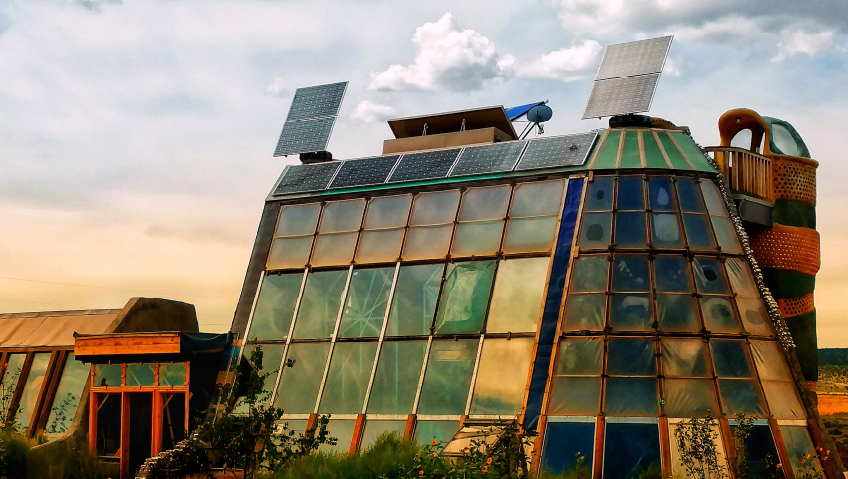Is escaping big city congestion to take on tiny houses and off-the-grid living that reduces our environmental footprint the answer? More and more of us who are packing up, downsizing, and moving to smaller dwellings and communities think so.
Whoever coined the proverb ‘one man’s trash is another man’s treasure’ might very well have been talking about Earthships.
While low-cost, readily available and sustainable natural materials like wood, bamboo, straw and stone have been used to create shelters for centuries, Earthships represent the ultimate in recycling and repurposing, since they are created from man-made products destined for the trash heap.
Earthships emerged as a unique housing alternative around the same time as the solar home craze of the 1970s, which, however, initially focused on architectural design and orientation rather than solar panels and energy storage.
The brainchild of Michael E. Reynolds, an architecture graduate from the University of Cincinnati, Earthships was inspired by televised stories about America’s growing waste problem, and the lack of affordable housing.
Seeking inexpensive solutions for making low-cost dwellings, Reynolds invented the “can brick.” Instead of throwing out used tins, he wired 10 empty cans together – “four flat and six unflattened,” according to his website – to create a new type of building block based on materials other than concrete, wood, or stone.
Realizing he was onto something low-cost and radically different from other kinds of construction products, Reynolds patented his invention in 1973.
Recycled can bricks, used to create walls, are just part of the reclaimed and natural materials used in Earthship construction. Other readily available “natural resources” as Reynolds calls them, include tires filled with earth, discarded pieces of wood and metal, glass bottles, and adobe mud for walls and floors.
Created according to six design principles, including using natural / repurposed materials, incorporating thermal / solar heating and cooling, harvesting water, contained sewage treatment, and solar and wind electricity, Earthships fundamentals also include in-home organic food production, which ensures maximum freshness for occupants while minimizing waste.
From the tires, glass bottles, cans, and other materials used to make them to gathering and saving rain and snowmelt (all water landing on one of these structures is reused four times) to growing vegetables and herbs in mini-hydroponic planters to maximize space, Earthships are the pinnacle in off-the-grid, environmentally sustainable living.
Just as Earthships are fast gaining popularity for their reasonable cost and self-sustainability in today’s social and environmentally conscious world, micro-communities are growing in number.
An alternative to loud, crowded, polluted and chaotic major cities, micro-communities – not to be confused with online social media ‘communities’ where like-minded people discuss similar interests – are on the rise. Also known as mini-communities, these areas comprise tiny homes, part of the “small house movement.”
Across the United States, Canada and other countries, residential codes are being amended to accommodate these little homes. Depending on location, Tiny Houses measure 600 square feet at most and are often much smaller. According to the Tiny Home Industry Association, a 510(c)(6) non-profit organization, these diminutive dwellings were approved for inclusion in the 2018 International Residential Code (IRC).
Constructed in a basically similar way to much larger homes, Tiny Houses often look like bungalows or cottages, but with some notable differences.
Apart from the obvious size difference compared to massive mansions adorned with marble Corinthian columns, these mini-houses are built on foundations, or come with wheels. While the latter version makes them easier to move from location to another, it also means that they have to be registered as RVs, and issued license plates.
For all practical purposes, Tiny Homes are better for the planet because living in a small space uses fewer resources, such as water and electricity. A minimal lifestyle also means fewer carbon emissions, and less consumption of home heating products like oil, gas, and propane.
From a construction perspective, an efficiently designed 400 square foot house requires a lot less drywall, wood, and other building materials than the average 2,500 square foot American home (according to the U.S. Census Bureau, there was a huge increase of more than 1,000 square feet in house dimensions from the 1,660 square foot average in 1973 to 2,687 square feet by 2015!). By the way, American homes are on average twice the size of houses in Italy, England, China, and many other countries.
Much like small condos in cities, Tiny Homes are also generational. Compared to pre-Internet days, more of us – especially millennials – are working remotely from home, instead of an office.
A Tiny Home not only affords workers this opportunity, but also the ability to relocate their Tiny Home to locations closer to their place of employment, at a fraction of the cost of purchasing and maintaining a much larger home. This allows them to spend more on life experiences such as travel, or purchasing their own land.
While smaller spaces have their disadvantages, mainly the obvious one of less room to live and store stuff, their growing appeal cannot be denied. A well-designed small house maximizes every inch of space, from sleeping lofts to kitchen counters. They are, by their very nature, intended for single persons or couples without children.
In some communities, tiny houses are serving humanitarian purposes. In Kansas City, Missouri, for example, the Veterans Community Project (VCP) is on a mission: to give some of the 37,000 homeless men and women who served the nation a place to live.
Completed in 2019, the VCP village is made up of 49 individual little houses on five acres that were bought by the organization from Kansas City for just $500. Measuring between 240 and 320 square feet, these Tiny Homes are proving themselves a safer, kinder, more dignified and more viable alternative to homeless shelters or living on the streets.
It’s not surprising most of us believe that the more densely populated the city, the greater are emissions of carbon dioxide (one of the main greenhouse gases behind global warming).
Worldwide, universities and research institutes like the Norwegian University of Science and Technology (NTNU) meticulously measure and compare the carbon footprint of cities. Others, such as the NASA Earth Observatory, also actively determine carbon dioxide emissions. According to NASA, the cities producing the most carbon are in Asia and North America, and include Hong Kong, Seoul, Guangzhou, New York, and Los Angeles in their number.
Major metropolitan areas, however, are not entirely responsible for the world’s carbon emissions.
According to the Global Gridded Model of Carbon Footprints (GGMCF), affluent suburbs are also relentlessly growing our carbon footprints.
While the huge sprawl of London is responsible for 11 percent of England’s greenhouse gases; smaller centers like Liverpool, Leeds, Swansea, Leicester, Peterborough, Birmingham, Portsmouth and others also significantly contribute to carbon-based pollution. This is according to Centre for Cities, an organization “dedicated to improving the economies of the UK’s largest cities and towns.”
Focusing on 63 key areas – specifically bigger cities and towns designated primary urban areas (PUAs) in its analysis – the Centre says it focused its research on “built-up” areas of large cities and towns, not “individual local authority districts.” Looking at PUAs and carbon emissions based on individual residents, it found that smaller towns and even individual persons and their dwellings in the countryside are responsible for significantly growing carbon emissions.
In the United States, suburbs are often portrayed as idyllic places embodying the best that cities can offer, but without the congestion. In fact, the truth may be a little different.
A study compiled by the University of California, Berkeley mapped areas by neighbourhood to determine carbon consumption, with red for high-emission areas, and green for low emissions. Looking at all forms of transportation along with household consumption including water, waste, construction, energy usage, food purchasing and other factors, it was revealed that certain neighbourhoods – even in the same city – generated significantly higher amounts of carbon, up to four times in some instances.
According to Berkeley News, “this consumption-based approach finds about 35 percent higher greenhouse gas emissions than the traditional territorial approach for the region, largely due to higher emissions from imported food and goods.”
While the UK remains one of the world’s lower carbon-emission producers at 5.7 tonnes per person according to the European Commission, the overall message remains the same: we all need to take on responsibility for reducing greenhouse gases. Whether in China with its estimated population of 1,439,323,776, or in Kansas City, Missouri and its population of about 492,000 – some of them veterans living in Tiny Homes – our world can only be the better for it.
From how and where we choose to live – be it a Tiny Home, suburban abode, or a massive mansion – to the amount we drive, the food and drink we consume, and our daily use of electricity, it all impacts everything from the air we breathe and water we drink, to the state of the entire planet we call home.













